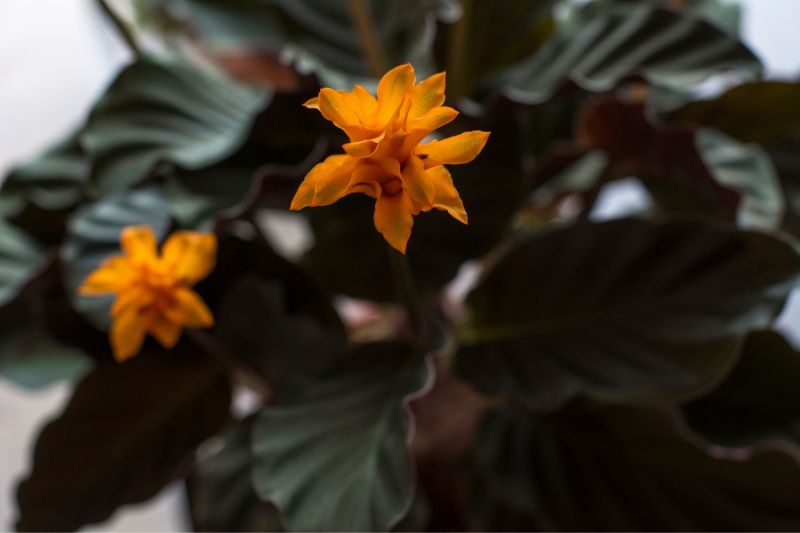Craving for more Calathea varieties for your collection and stumbled upon the lovely Eternal Flame? You’re in for a treat!
This captivating plant, scientifically known as Goeppertia Crocata (syn, Calathea Crocata), is renowned for its orange flowers that add a burst of energy to your indoor space. In this article, we’ll walk you through everything you need to know to provide the best care for your Eternal Flame.
So let’s dive in!
Table of Contents
1. General Information & Taxonomy
| Scientific name: | Goeppertia crocata |
| Common names: | Eternal Flame, Tassmania Plant, Calathea Crocata |
| Native to: | Brazil, South America |
| Toxicity: | Non-toxic to pets |
| Mature size: | Up to 2 feet tall |
| Category: | Tropical perennial |
| Growth Rate: | Moderate |
| Dormancy period: | None |
| Hardiness: | USDA Zones 10-11 |

2. Calathea Crocata Care & Growing Requirements
» Watering
Striking a moisture balance is key for the Calathea Crocata. It thrives when the soil is consistently moist but not soggy, and it definitely doesn’t like dry soil conditions. Wait until the top inch of the soil feels dry before watering, and opt for distilled or rainwater to avoid chemical sensitivities.
» Light
Bright, indirect light is the sweet spot for this plant. Direct sunlight can scorch its delicate leaves, so consider placing it in a north or east-facing window.
» Soil
A well-draining, peat-based potting mix works wonders for Calathea Crocata. Ensure that the soil allows good aeration to prevent root rot.
» Temperature
This tropical beauty thrives in temperatures ranging from 65-75°F (18-24°C). Keep it away from drafts and sudden temperature changes.
» Humidity
High humidity levels (around 60-70%) are ideal for keeping your Calathea happy. You can achieve this by using a humidity tray, or placing it in a room with a humidifier.
» Fertilizer
Fertilize your Calathea Crocata once a month during the growing season (spring and summer) with a balanced, water-soluble fertilizer diluted to half-strength. Avoid fertilizing during the winter months.
3. Calathea Crocata Maintenance and Propagation
» Repotting
Repot your Calathea Crocata every 1-2 years or when it outgrows its container. Always choose a pot that’s just a couple of inches larger in diameter than the current one.
» Pruning
Remove dead or yellow leaves and faded blooms to encourage new growth. Pruning is best done during the growing season.
» Propagation
Calathea Crocata is best propagated through division. Gently separate the plant’s roots during repotting and place them in separate containers filled with appropriate potting mix.
4. Common Issues
- Leaves Turning Yellow: Overwatering is usually the culprit. Check the soil moisture and adjust your watering schedule accordingly. Other issues like underwatering, low humidity levels, overfertilizing, or temperature fluctuations can also lead to yellowing leaves.
- Leaves Turning Brown: This could be due to low humidity or the presence of chemicals in the water. Use distilled or rainwater and increase humidity levels.
- Drooping Leaves: Often a sign of stress due to environmental changes. Check for issues with light, temperature, and watering.
- Faded Colors: Inadequate light can cause the leaves to lose their vibrant colors. Move the plant to a brighter spot but avoid direct sunlight.
5. Calathea Crocata Diseases & Pests
Watch out for common pests like spider mites and aphids. Treat any infestations with insecticidal soap or neem oil. Root rot can occur if the plant is left in waterlogged soil, so make sure your pot has good drainage.
Conclusion
Taking care of a Calathea Crocata might require a bit of your attention, but the reward is a stunning, vibrant plant that adds life and color to any space. With proper care and maintenance, this tropical treasure can thrive in your home for years to come.
Make sure to check out our article on orange-flowering houseplants and plants with black leaves for more inspiration!






No Comments